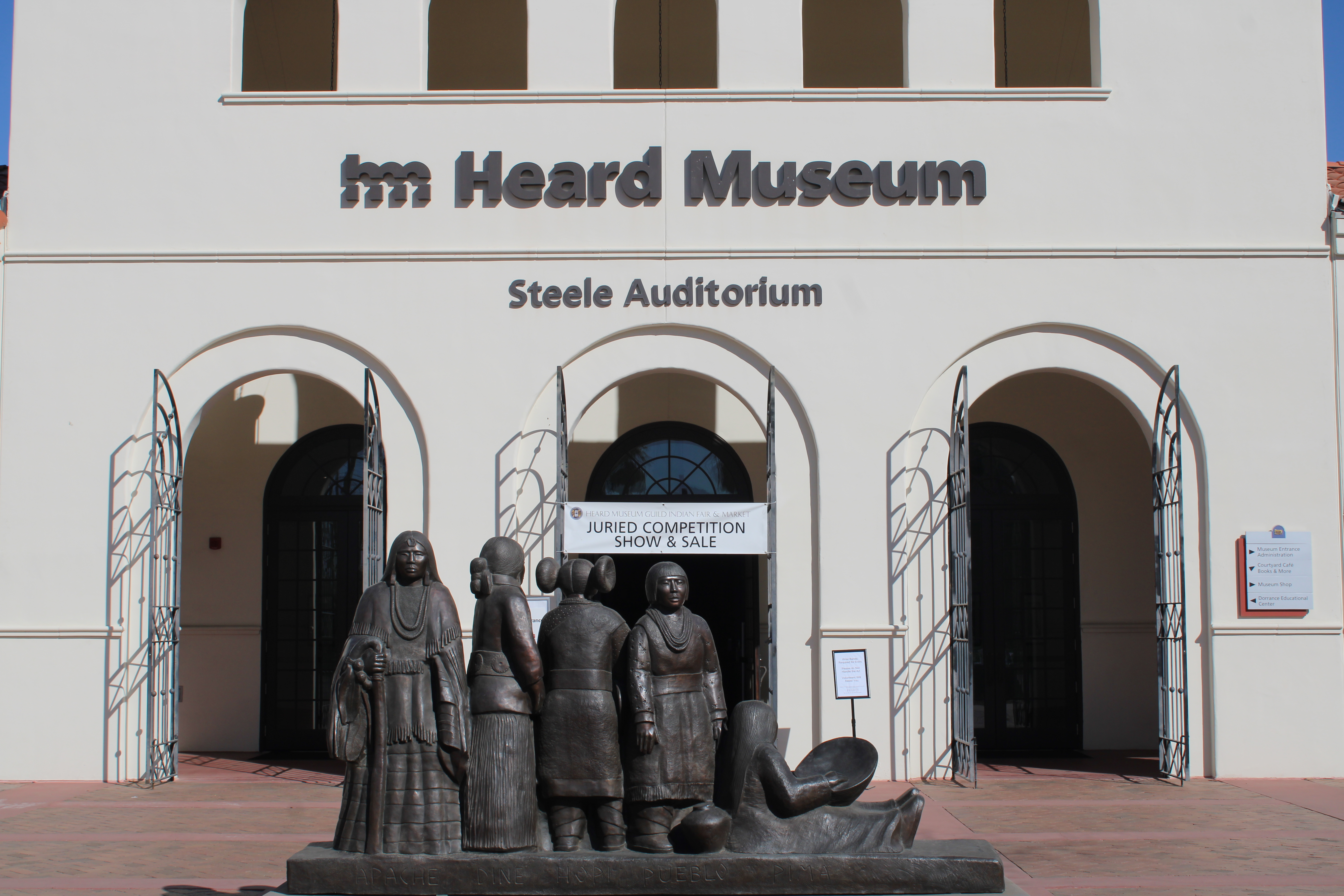
- Details
- By Darren Thompson
PHOENIX, Ariz. — The world renowned Heard Museum Guild hosted its 63rd annual Indian Fair & Market over the weekend, featuring Native American art from more than 325 artists with more than 80 tribal affiliations from Alaska to Maine. Due to the coronavirus pandemic, this year’s event was dubbed as a hybrid fair with the majority of activities (such as the art market, performances and artist interviews) held virtually, and some artists showcasing their work live in the museum shop.
In non-pandemic times, the Heard Museum Guild Indian Fair & Market draws nearly 15,000 visitors featuring more than 600 of Indian Country’s most outstanding and successful American Indian artists, according to the Heard Museum. However, due to the pandemic, event staff say attendance was well under 1,000.
Juanita Growing Thunder Fogarty’s “Wakitantanka (Strong-Willed) Pandemic Survivalist” was awarded “Best of Show” in the 2021 Juried Competition at the Heard Museum Guild Indian Fair & Market. Growing Thunder Fogarty is Assiniboine/Sioux from Fort Peck, Mont. and has won numerous awards at the Santa Fe Indian Art Market and has previously won a First Place Award at last year’s Indian Fair & Market at the Heard Museum.

“(Juanita Growing Thunder Fogarty’s) work is unmatchable,” said Mdewakanton Dakota artist Cole Redhorse Jacobson to Native News Online.
Cole Redhorse Jacobson has been attending the Heard Indian Fair & Market for the last three years, and expressed hopes for this year’s mainly virtual event. “I was excited that the Heard Museum was able to host the event virtually this year, for the safety of everyone,” said Jacobson.
“My hopes this year are to continue to share my work and to challenge myself to make new creations to submit for other juried art shows,” said Jacobson. “It’s amazing just to have my work in the same room as all the greats.”
Angela Babby, Oglala Lakota, also submitted several pieces and won second place in the mixed media category for her piece “Hewcel Oyatekinipikte—So That Our People May Live.” However, it was her piece “Are You Not Entertained?” that earned a lot of buzz at the art show.
“I was advised by people I love not to create ‘Are You Not Entertained?,’” said Angela Babby to Native News Online. “How can a person live through the events of the past four years, live in America while it is still a democracy and not make some comment on what has transpired? I could not do it. Art is not always about beauty.”
The most commonly seen image in Babby’s piece “Are You Not Entertained?” looks like what many people would identify as a “swastika.” However, the image is Roman, according to Babby. “The ‘swastika’ represented the four seasons in Roman culture. Native Americans also admired this symbol and used it to represent the whirlwind,” said Babby. “I used the tile design to express how designs, languages and choices humans make have consequences.”

In the lower image of Babby’s “Are You Not Entertained?” is a depiction of Medicine Bottle and Little Six after they were kidnapped, drugged and brought back to Minnesota for the hanging of the Dakota 38 on Dec. 26, 1862.
“This work for me is a record, in my most permanent medium,” said Babby. “I show with sadness how there have always been people in power who claim others are dangerous and need to be killed because they broke the law, because they are traitors or criminals.”
Although Babby didn’t travel to Phoenix to participate in the live art show, she was able to participate in the virtual show, but her QR code didn’t connect immediately to her website. “It was great to hear about every winner’s piece from the artist themselves,” Babby said. “The virtual show has the potential to reach so many more people.”
The Heard Museum Guild Indian Fair & Market is the largest art market in Arizona and the second largest of its kind in the country. This year’s pool prize was the largest in the fair’s history with $76,150 for 110 awards across 10 classifications.
More Stories Like This
Vision Maker Media Honors MacDonald Siblings With 2025 Frank Blythe AwardFirst Tribally Owned Gallery in Tulsa Debuts ‘Mvskokvlke: Road of Strength’
Zuni Youth Enrichment Project and Partners at Ho’n A:wan Productions Launch 8th Annual Delapna:we Project
Chickasaw Holiday Art Market Returns to Sulphur on Dec. 6
Center for Native Futures Hosts Third Mound Summit on Contemporary Native Arts
Help us defend tribal sovereignty.
At Native News Online, our mission is rooted in telling the stories that strengthen sovereignty and uplift Indigenous voices — not just at year’s end, but every single day.
Because of your generosity last year, we were able to keep our reporters on the ground in tribal communities, at national gatherings and in the halls of Congress — covering the issues that matter most to Indian Country: sovereignty, culture, education, health and economic opportunity.
That support sustained us through a tough year in 2025. Now, as we look to the year ahead, we need your help right now to ensure warrior journalism remains strong — reporting that defends tribal sovereignty, amplifies Native truth, and holds power accountable.
 The stakes couldn't be higher. Your support keeps Native voices heard, Native stories told and Native sovereignty defended.
The stakes couldn't be higher. Your support keeps Native voices heard, Native stories told and Native sovereignty defended.
Stand with Warrior Journalism today.
Levi Rickert (Potawatomi), Editor & Publisher
